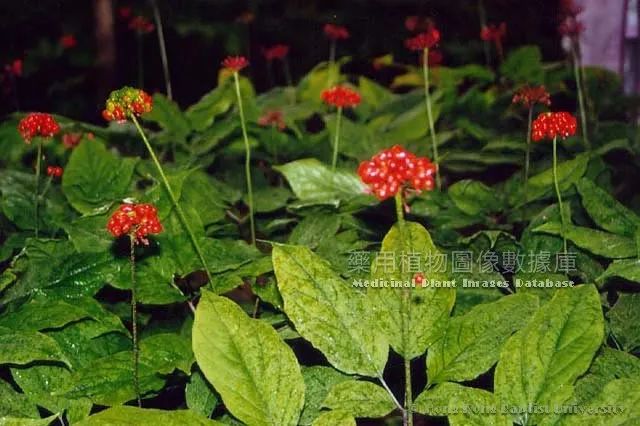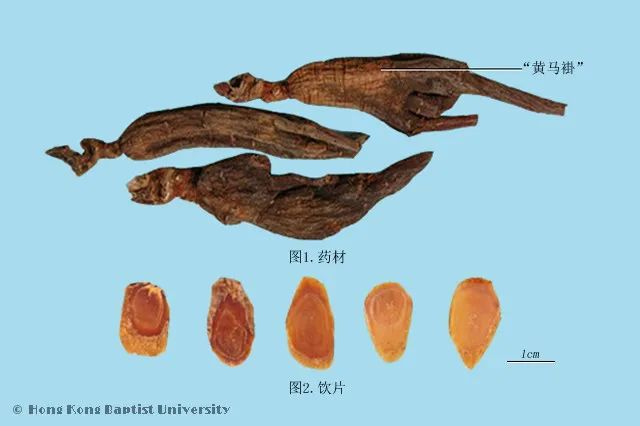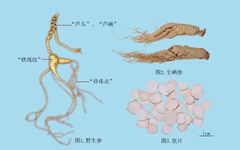Introduction
Ginseng has a wide range of uses and is highly favored by the public. However, the understanding of ginseng is often quite vague.
Everyone knows that ginseng tonifies Qi (vital energy). But different classifications of ginseng have different functions, which is not widely known. Therefore, today we will discuss the basic knowledge about ginseng.
Ginseng is the dried root and rhizome of the plant Panax ginseng, first recorded in the Han Dynasty’s “Shennong Bencao Jing” (Shennong’s Classic of Materia Medica).
Why is it called ginseng? Because ginseng resembles the shape of a human, it is named ginseng.
However, most of the ginseng available on the market today is cultivated, known as garden ginseng. Garden ginseng does not resemble a human shape as much.
True human-shaped ginseng is wild mountain ginseng. The main stem and branches of wild mountain ginseng resemble the human body and limbs.

▲Image source: Hong Kong Baptist University Traditional Chinese Medicine Material Image Database
How is ginseng classified?
1. Classification by Origin
First, we have all heard of Korean ginseng, which is a variety of ginseng. Many people subconsciously think that Korean ginseng is a high-grade ginseng. Is this perception correct? It can only be said to be half true.
Korea is one of the origins of ginseng. Some ginseng is named according to its place of origin. For example, ginseng from Korea is called Korean ginseng, also known as high-grade ginseng. Most of the Korean ginseng seen in the market today is actually produced in South Korea and is processed from garden ginseng.
Jilin in Northeast China is also a famous ginseng-producing area, and ginseng from there is called Jilin ginseng. Ginseng that grows near the Changbai Mountain in the XinKai River basin is called XinKai River ginseng, while ginseng from the Shangdang area is called Shangdang ginseng. There is often a misunderstanding regarding Shangdang ginseng, as many people subconsciously associate the character “党” (dang) with Codonopsis pilosula (Dang Shen), but it is not Dang Shen; it is genuine ginseng. Ginseng belongs to the Araliaceae family, while Dang Shen belongs to the Campanulaceae family, which are two different species.
Additionally, there is Dongyang ginseng produced in Japan, which has general efficacy and is not commonly used in China.
Another type with relatively high cost-performance is Russian ginseng. It is important to know that ginseng prefers cool, shaded areas or relatively cold regions. In terms of origin, the coldness of ginseng from Northeast China is comparable to that of the Russian region, so in terms of origin, Korean ginseng does not have much of an advantage. However, due to good commercial packaging and quality control, it has formed a brand. Customer trust in a brand often stems from confidence in quality control.
Thus, in terms of environmental origin, Korean ginseng does not have an advantage over the other ginseng mentioned, except for Dongyang ginseng.
This is the classification of ginseng based on origin.

2. Classification by Growth Environment
This can be divided into three main categories.
The first category is garden ginseng. Garden ginseng is artificially cultivated ginseng. Most of the red ginseng and white ginseng seen on the market are mostly garden ginseng processed through different methods.
The second category is wild mountain ginseng. Wild mountain ginseng grows in primitive mountain forests at altitudes of 1,000 to 2,000 meters and has a history of several thousand years in China. The main countries producing wild mountain ginseng are China, Russia, and North Korea.
Wild mountain ginseng is mostly processed into raw sun-dried ginseng. However, the raw materials for raw sun-dried ginseng are not all wild mountain ginseng.
We say that wild mountain ginseng is the best for tonifying Yuan Qi (vital energy). However, due to changes in the natural environment and continuous harvesting by humans, wild mountain ginseng has become increasingly rare and precious. The natural wild mountain ginseng growing in Jilin’s Changbai Mountain and its foothills is particularly valuable. The older the ginseng, the larger it tends to be, and thus the more expensive it is. There used to be a saying, “Seven taels is ginseng, eight taels is treasure,” but now such large wild mountain ginseng is extremely rare.
The third category is transplanted mountain ginseng. Transplanted mountain ginseng has efficacy that lies between wild mountain ginseng and garden ginseng.
Transplanted mountain ginseng, as the name suggests, is ginseng that has been transplanted and possesses some characteristics of wild mountain ginseng. There are two types of transplanted mountain ginseng: “mountain transplant” and “home transplant.”
“Mountain transplant” refers to when farmers find wild mountain ginseng seedlings while foraging in the mountains. Due to their weight and young age, they are not suitable for sale, so they are concentrated and transplanted to nearby mountain forests for easier management and natural growth.
“Home transplant” refers to when ginseng farmers transplant garden ginseng seedlings to mountain forests, without watering or fertilizing, allowing them to grow naturally in the wild.
Transplanted mountain ginseng is also becoming increasingly rare due to the difficulty of cultivation. Currently, a similar type is forest-grown ginseng.
Forest-grown ginseng is when garden ginseng seeds are sown in a natural environment, allowing them to grow naturally without transplanting, covering, fertilizing, using pesticides, weeding, or tilling. After about 10 years, they are harvested as semi-wild mountain ginseng, also known as cultivated mountain ginseng.
This method is quite similar to transplanted mountain ginseng, and forest-grown ginseng is now often regarded as having similar effects to transplanted mountain ginseng.
In summary, based on cultivation methods, wild mountain ginseng has the strongest efficacy, while transplanted mountain ginseng and forest-grown ginseng also have good effects.
Compared to wild mountain ginseng and transplanted mountain ginseng, garden ginseng is artificially cultivated and has relatively weaker efficacy. However, whether it is significantly weaker is not certain.
This concludes the classification of ginseng based on origin and cultivation methods.
3. Classification by Processing Methods
The first category is raw sun-dried ginseng. This is when fresh ginseng is cleaned and then air-dried or dehydrated, resulting in raw sun-dried ginseng. As mentioned earlier, wild mountain ginseng is mostly made into raw sun-dried ginseng. It should be noted that the source of raw sun-dried ginseng is not all wild mountain ginseng. Most of the raw sun-dried ginseng on the market comes from garden ginseng.
The second category is red ginseng. This is made by steaming fresh ginseng, which causes the special starch in the ginseng to turn a light red color, resulting in red ginseng.

▲Red ginseng Image source: Hong Kong Baptist University Traditional Chinese Medicine Material Image Database
What is the difference between red ginseng and raw sun-dried ginseng?
In terms of efficacy, red ginseng has a stronger warming property. Generally, it is better for individuals with a Qi deficiency and a cold constitution to use red ginseng. Raw sun-dried ginseng has a relatively neutral flavor and is more suitable for those who are prone to heat.
The third category is white sugar ginseng. White sugar ginseng, abbreviated as sugar ginseng, is made from fresh ginseng that is not suitable for processing into red ginseng due to insufficient sap and poor shape. It is blanched in water, soaked in sugar, and then dried. Generally, the grade of white sugar ginseng is not very high. White sugar ginseng has a mild warming property and is used similarly to raw sun-dried ginseng.
Currently, the most common types on the market are raw sun-dried ginseng and red ginseng, especially red ginseng. Most red ginseng is artificially cultivated and made from garden ginseng. Does this mean its efficacy is weak? Not necessarily. Red ginseng itself also comes in different grades. When buying red ginseng at a pharmacy, cheaper options may cost two to three yuan per gram, while high-quality ones, like Korean ginseng, belong to the red ginseng category.
4. Classification by Medicinal Parts Used
One category is whole root ginseng, where the entire root and root hairs are used medicinally. Compared to other single medicinal parts, its efficacy is stronger.
The second category is bent root ginseng, which only uses the root hairs. Its Qi tonifying effect is weaker, but it has better fluid-generating properties.
The third category is branch ginseng, which only uses the branch roots. Naturally, its efficacy is weaker than that of whole root ginseng.

What are the benefits of ginseng?
Next, let’s discuss the properties and benefits of ginseng.
First, the properties of ginseng are: sweet, slightly bitter, and slightly warm.
1. Greatly tonifies Yuan Qi
Yuan Qi refers to the most fundamental and important Qi in the human body. Textbooks generally describe it as ginseng being able to treat severe Qi deficiency, where the pulse is weak and on the verge of collapse. This means that Qi deficiency is very serious, close to Qi collapse, commonly referred to as a state of extreme weakness. In such cases, ginseng can be used. It is important to note that wild mountain ginseng is the best choice here. If wild mountain ginseng is not available, then forest-grown ginseng can be used. If forest-grown ginseng is also unavailable, then raw sun-dried ginseng or red ginseng can be used, but it should be of high quality.
Additionally, is it necessary to wait until the point of collapse to use it? Not necessarily.
We can expand the concept of Yuan Qi. In addition to Qi collapse or near collapse, generally, kidney Qi is also deficient. We can consider kidney Qi deficiency as being close to Yuan Qi deficiency.
Moreover, Yuan Qi is distributed throughout the body via the San Jiao (Triple Burner), serving as a support for the Qi of all organs. Therefore, when there is a deficiency in the spleen Qi, heart Qi, or lung Qi, if it is not severe, we usually choose to use herbs that tonify the corresponding organ Qi, such as Huang Qi (Astragalus) or Dang Shen (Codonopsis) for spleen and lung Qi deficiency.
If a certain organ’s Qi is severely deficient, for example, when a healthy person’s Qi is at 100%, and a certain organ’s Qi is severely deficient, dropping below 50%, even if the diagnosis still states spleen Qi deficiency or lung Qi deficiency, it has already harmed Yuan Qi. Therefore, when organ Qi deficiency is very severe, we often use ginseng to greatly tonify Yuan Qi.
To emphasize the concept again, Yuan Qi is distributed throughout the body via the San Jiao, and Yuan Qi is the support for the Qi of the organs.
Famous formulas for greatly tonifying Yuan Qi include Du Shen Tang (Ginseng Decoction). It is best to use wild mountain ginseng for Du Shen Tang. Another is Shen Fu Tang (Ginseng and Aconite Decoction), which not only greatly tonifies Yuan Qi but also greatly tonifies Yang Qi. Additionally, Sheng Mai San (Generate the Pulse Powder), which consists of three ingredients: ginseng, Mai Dong (Ophiopogon), and Wu Wei Zi (Schisandra), is used in cases of both Qi and Yin deficiency. Of course, in Sheng Mai San, the quality of ginseng matters; if it is paired with Dang Shen, the efficacy is relatively weaker, while pairing with regular ginseng enhances the efficacy. If it is made into a decoction rather than a patent medicine, using wild mountain ginseng or forest-grown ginseng with Mai Dong and Wu Wei Zi will result in a very strong Sheng Mai San.
2. Tonifies the Qi of the Five Zang and Six Fu Organs
I am not fond of the textbook expression of tonifying spleen Qi or lung Qi.
When it comes to tonifying spleen Qi or lung Qi, can heart Qi be tonified? Can gallbladder Qi be tonified? Can stomach Qi be tonified? Actually, ginseng can tonify all of them. Therefore, I would express it as ginseng tonifies the Qi of the Five Zang and Six Fu organs. This means that regardless of which organ has Qi deficiency, ginseng can be used. If a person has Qi deficiency and you are unsure of the precise diagnosis, you can use ginseng because it can tonify the Qi of all the organs. As stated in the “Bencao Xinbian” (New Compilation of Materia Medica), “Ginseng is the holy medicine for tonifying Qi, the spiritual seed that revives people. It can enter the Five Zang and Six Fu organs, reaching every meridian, not just entering the spleen, lung, and heart but also the liver and kidneys.”
3. Generates fluids and alleviates thirst
This benefit is used in cases of both Qi and fluid deficiency.
In the “Shang Han Lun” (Treatise on Cold Damage), there is a formula called Bai Hu Jia Ren Shen Tang (White Tiger Decoction with Ginseng). This formula is used to treat high fever, with symptoms of great heat, profuse sweating, extreme thirst, and fatigue, indicating that heat has damaged both Qi and fluids. Bai Hu Tang is used to clear heat, while ginseng both tonifies Qi and generates fluids.
Similarly, in the later stages of febrile diseases, the bamboo leaf and gypsum decoction in the “Shang Han Lun” also includes ginseng, primarily to tonify Qi and fluids. In cases of mild Qi deficiency, I would choose ginseng roots. The Qi tonifying effect of ginseng roots is not as strong as that of the main ginseng body, but the fluid-generating effect is better than that of the main ginseng body.
Therefore, the choice of part depends on whether the focus is on tonifying Qi or generating fluids.
Additionally, there are very cheap, robust fresh ginseng varieties seen on the market, which are often used in soups by people in Guangdong. Their function is also to tonify Qi and generate fluids, but their efficacy is relatively weak.
Ginseng’s fluid-generating properties are also needed for diabetes. In Traditional Chinese Medicine, diabetes is generally classified as “Xiao Ke” (wasting-thirst), which often presents with Qi deficiency and a feeling of thirst, so ginseng is commonly used for this condition.
4. Calms the spirit and enhances intelligence
I am not satisfied with the term “calm the spirit” used in textbooks.
We know that ginseng has a stimulating effect. This means that when the spirit is lethargic and fatigued, consuming ginseng can invigorate the spirit. However, if a person is very fatigued and cannot sleep, taking ginseng can help them sleep; this is what it means to calm the spirit.
Therefore, the effect of ginseng on the spirit should be expressed as regulating the spirit.
Regarding the effect of ginseng on regulating the spirit, the “Shennong Bencao Jing” describes it as follows: “It mainly tonifies the Five Zang, calms the spirit, stabilizes the soul, stops palpitations, eliminates evil Qi, brightens the eyes, uplifts the mood, and enhances intelligence. Long-term use lightens the body and prolongs life.”
5. Benefits Qi and strengthens Yang
When it comes to strengthening Yang, many people think of sexual function. Does ginseng have the effect of enhancing sexual function? Yes. However, using ginseng alone to enhance sexual function is not very strong. Generally, it needs to be paired with deer antler, as deer antler greatly tonifies Yang Qi, while ginseng greatly tonifies Yuan Qi. The combination of these two herbs can treat male kidney deficiency and impotence, as well as female low libido. In Hong Kong, you often see Chinese medicine shops not called Chinese medicine shops, but rather ginseng and deer antler shops, as ginseng and deer antler are often sold together. The naming may imply that the shop sells high-quality or precious Chinese medicine.
6. Supports the righteous and expels evil
This is the expression used in textbooks. If I were to explain it, I would be more cautious and remove the term “expel evil.” Ginseng actually helps expel evil by supporting the righteous, rather than having a direct expelling effect.
For example, if a person has an exterior condition, they may use warming or cooling herbs to induce sweating.
Most TCM enthusiasts may feel that individuals with Qi deficiency are particularly susceptible to exterior conditions. In such cases, exterior-releasing herbs can often be paired with an appropriate amount of ginseng to tonify Qi.
Why use ginseng? Because ginseng tonifies Qi and does not easily retain evil.
In contrast to another herb, Huang Qi (Astragalus), which tonifies Qi and can also stabilize the exterior, is generally used to tonify Wei Qi (defensive Qi) for those who are prone to colds. However, using Huang Qi during an active cold is not ideal, as it stabilizes the exterior and makes it difficult to induce sweating. In the case of a cold, using Huang Qi is not ideal, but using ginseng is fine. In TCM, there are representative formulas like Ren Shen Bai Du San (Ginseng Decoction to Overcome Pathogenic Factors) and Shen Su Yin (Ginseng and Perilla Decoction), which embody this principle, using ginseng to address the underlying Qi deficiency while using other exterior-releasing herbs to treat the current exterior symptoms.
【Source: TCM Teacher Pan Yi, Author: Professor Pan Yi, MD, PhD Supervisor, Director of the Department of Basic Theories of Traditional Chinese Medicine, Guangzhou University of Chinese Medicine, Vice Chairman of the Basic Theory Research Professional Committee of Guangdong Province Chinese Medicine Association】
Recommended Reading



